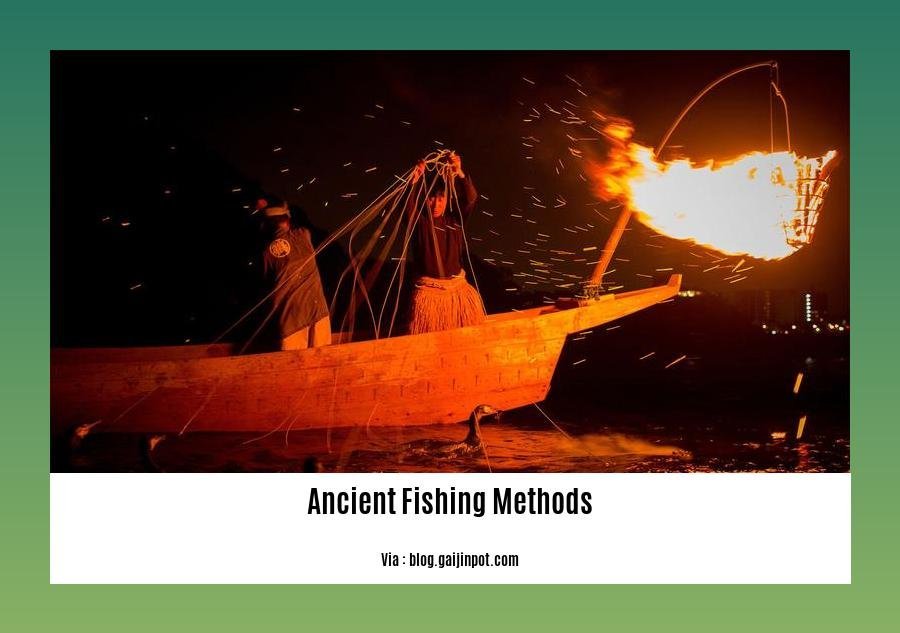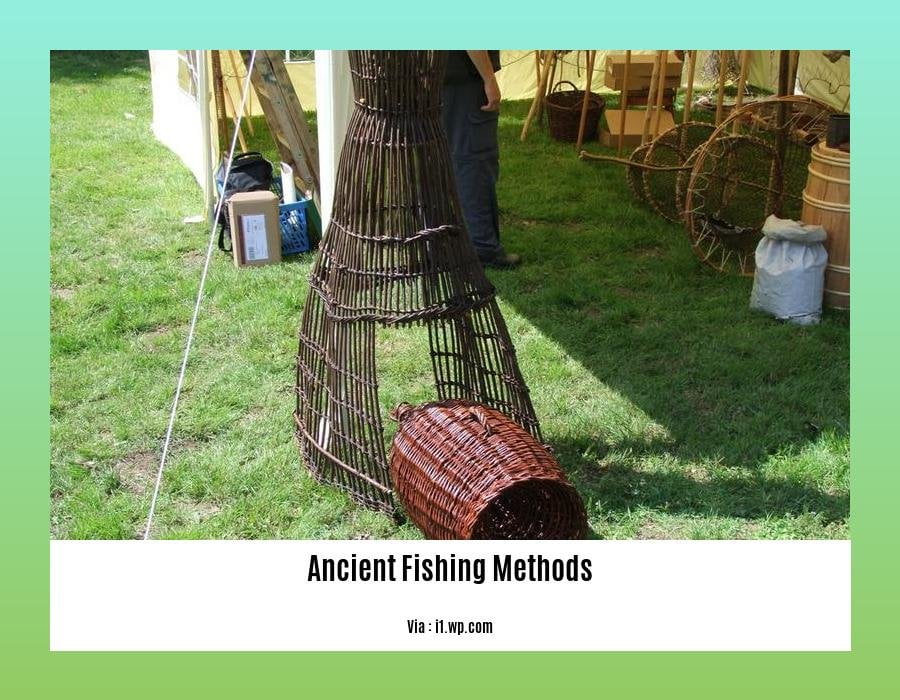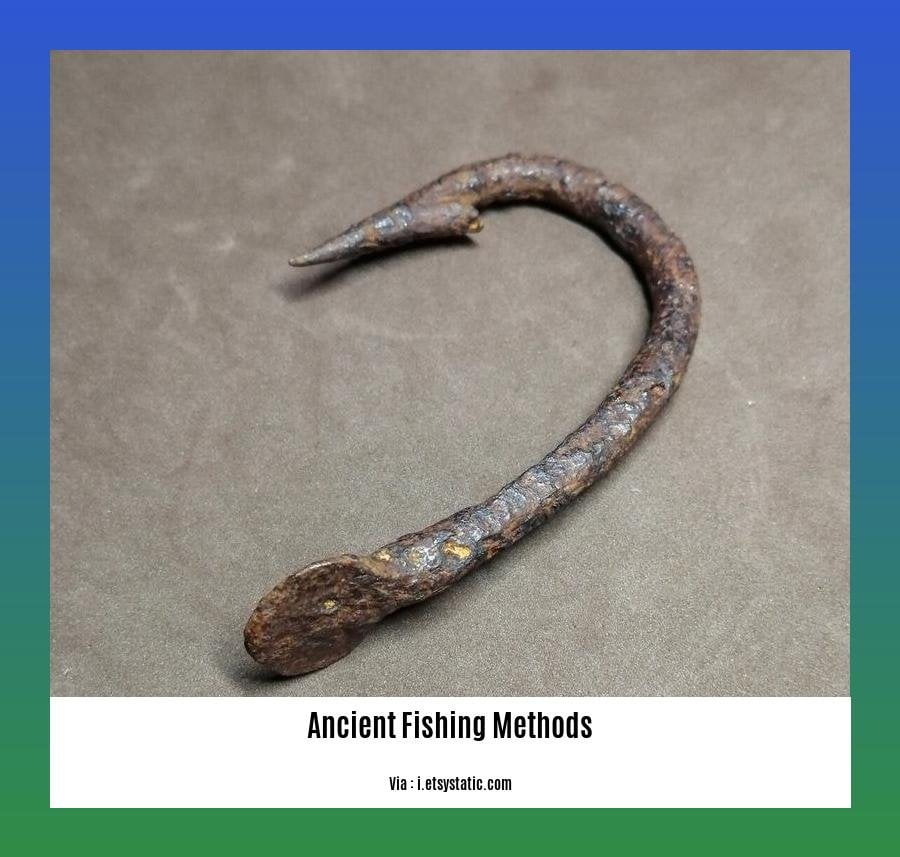Take a dive into the depths of history and explore the captivating world of [Ancient Fishing Methods: Unraveling the Ingenuity of Our Ancestors]. Discover the remarkable techniques and strategies employed by our forefathers as they harnessed the bounty of the seas, shaping coastal communities and leaving an enduring legacy of innovation and sustainability.
Key Takeaways:
- Cormorant Fishing:
Originating from China and Japan, this method involves trained cormorants attached to a line to dive and retrieve fish.
Bajau Sea Bed Fishing:
The Bajau people of Southeast Asia use simple tools to walk on the seabed, collect marine life, and gather fish, mollusks, and other aquatic creatures.
Flounder Tramping:
This traditional technique involves wading in shallow waters and stepping on flounder fish to stun them, making them easy to collect by hand or with a net.
Otter Fishing:
Fishers use trained otters to retrieve fish in the water.
Trout Tickling:
- In shallow streams or rivers, trout are gently tickled until they become subdued enough to be caught by hand.
Ancient Fishing Methods:

Unveiling the Creativity and Resilience of Our Ancestors
In the vast tapestry of human history, ancient fishing methods stand as testaments to the ingenuity and resilience of our ancestors. These techniques, born out of necessity and honed through generations of experience, reveal a profound connection between humans and the sea. From the earliest rudimentary tools to the development of sophisticated methods, ancient fishing practices offer valuable insights into the cultural, economic, and ecological aspects of past societies.
Bridging the Past and Present
Exploring ancient fishing methods is not merely an exercise in historical curiosity; it is a journey that connects the past with the present. By understanding the challenges and solutions of our ancestors, we gain a deeper appreciation for the challenges facing modern fisheries and the importance of sustainable practices. The wisdom of the ancients can inspire contemporary solutions, fostering a harmonious relationship between humanity and the marine environment.
Sustainable Practices and Environmental Adaptations
Many ancient fishing methods exhibited a remarkable awareness of ecological balance. Techniques such as selective fishing, seasonal restrictions, and habitat conservation ensured the long-term viability of fish populations. These practices provide valuable lessons for contemporary fisheries management, emphasizing the need for responsible stewardship of marine resources.
Diversity and Adaptation
The sheer diversity of ancient fishing methods reflects the remarkable adaptability of our ancestors to a wide range of environments. From the shallows of coastal waters to the depths of the open ocean, ancient fishing techniques were tailored to specific ecosystems and fish species. This diversity showcased the ingenuity and problem-solving skills of ancient civilizations.
Cultural Significance of Fishing
Beyond sustenance, fishing held profound cultural significance for many ancient societies. It was a source of livelihood, a symbol of community identity, and a representation of spiritual beliefs. Fishing rituals, festivals, and myths abounded, weaving fishing into the very fabric of ancient cultures.
Conclusion
The study of ancient fishing methods is a fascinating exploration of human ingenuity, adaptability, and cultural expression. From the simple hooks and lines of early civilizations to the sophisticated techniques of later periods, these methods hold valuable lessons for the present. By understanding the wisdom of our ancestors, we can strive to create a sustainable future for fishing, ensuring that this vital practice continues to nourish and inspire generations to come.
To truly delve into the ancient Chinese military’s structure, exploring ancient Chinese military ranks would be an insightful journey.
The ancient coins of India hold captivating tales of historical and cultural significance, inviting numismatists and enthusiasts alike to discover their stories.
If you’re interested in collecting or learning more about the historical value of ancient coins, exploring ancient coins of India price would be a worthwhile pursuit.
Environmental adaptations and how they influenced fishing methods
Fishing methods employed by ancient civilizations were intricately linked to their environment, exhibiting ingenious adaptations to maximize their catch. Let’s dive into how environmental factors shaped these ancient fishing practices:
Environmental Adaptations and Fishing Methods
1. Water Bodies: The type of water body significantly influenced fishing techniques.
– Rivers and Lakes: Ancient communities near rivers and lakes used spears, nets, and traps adapted to freshwater environments.
– Oceans and Coasts: Coastal and ocean-dwelling communities relied on boats, harpoons, and large nets to navigate and catch marine fish.
2. Fish Species: Different fish species required specialized fishing methods:
– Bottom-Dwelling Fish: Techniques like bottom trawling and longlining were used to target fish living near the seafloor.
– Surface-Feeding Fish: Hooks and lures were employed to catch fish that feed near the water’s surface.
– Migratory Fish: Ancient fishers used ingenious traps and nets to intercept fish during their seasonal migrations.
3. Climate and Weather: Environmental conditions played a crucial role:
– Seasonal Changes: Fishing methods adapted to seasonal variations in fish behavior and availability.
– Weather Patterns: Ancient fishers knew how to interpret weather patterns to predict fish movements and adjust their fishing strategies accordingly.
4. Tides and Currents: Coastal communities mastered techniques that utilized tides and currents to their advantage:
– Tidal Traps: Fish were trapped in tidal pools as the tide receded, making them easy to collect.
– Current Nets: Nets were positioned to capture fish swept away by strong currents.
5. Shoreline and Topography: Shoreline features also influenced fishing methods:
– Rocky Coastlines: Harpoons and spears were used to target fish hiding among rocks.
– Sandy Beaches: Nets and seines were employed to catch fish close to shore.
– Coral Reefs: Specialized traps and nets were designed to navigate coral reef ecosystems.
6. Marine Resources: The availability of materials like wood, bone, and shells influenced fishing gear and boat construction:
– Wood: Boats, spears, and traps were crafted from locally available wood.
– Bone and Shells: Hooks, harpoons, and ornaments were made from animal bones and shells.
Key Takeaways:
- Ancient fishing methods were shaped by environmental factors like water bodies, fish species, climate, tides, and shoreline features.
- Fishers adapted their techniques to target specific fish species and navigate diverse aquatic environments.
- The ingenuity of ancient fishing methods highlights their understanding of fish behavior, seasonal changes, and marine ecosystems.
- Studying ancient fishing practices provides insights into the relationship between humans and the environment and inspires sustainable fishing practices today.
Sources:
- Ancient Fishing Technologies and Their Environmental Adaptations
- The Environmental Adaptations of Ancient Fishing Methods
Sustainability and conservation in ancient fishing practices

Sustainability and conservation were inherent in ancient fishing practices. Our ancestors understood the balance between taking from nature and preserving it for future generations. Selective fishing techniques, such as targeting specific fish sizes and releasing females, ensured healthy fish populations.
Fishing with a Conscious Mind
Ancient Indigenous communities possessed a profound understanding of marine ecosystems. They employed various methods to minimize their impact on the environment, including:
Selective Harvesting: Ancient fishers used selective harvesting methods to target specific fish sizes or species, ensuring the survival of juvenile fish and allowing fish stocks to replenish naturally.
Seasonal Fishing: To maintain a balance in fish populations, ancient communities observed seasonal fishing patterns, respecting fish spawning and breeding cycles.
Habitat Preservation: Ancient fishing practices often involved protecting fish habitats, such as coral reefs and mangrove forests, recognizing their importance for fish breeding and survival.
Minimal Bycatch: Ancient fishers employed techniques that minimized bycatch, the unintentional capture of non-target species. They used selective gear and methods to reduce harm to marine life.
Community-Based Management: Many ancient fishing communities operated under community-based management systems, where rules and regulations were established collectively to ensure sustainable fishing practices.
Lessons from the Past for a Sustainable Future
The sustainability and conservation practices employed by ancient fishers offer valuable lessons for modern fisheries management:
Adaptive Management: Ancient fishers adapted their techniques to changing environmental conditions. Today, adaptive management strategies can help fisheries respond to climate change and other environmental challenges.
Community Engagement: Ancient fishing communities relied on local knowledge and cooperation. Encouraging community involvement in modern fisheries management can lead to more effective and sustainable outcomes.
Precautionary Approach: Ancient fishers often adopted a precautionary approach, avoiding practices that could harm fish populations. Applying this approach today can help prevent overfishing and protect marine ecosystems.
Education and Awareness: Ancient fishing practices can inspire educational programs that raise awareness about the importance of sustainable fishing and the preservation of marine ecosystems.
Key Takeaways:
- Ancient fishing practices demonstrated a deep understanding of marine ecosystems and the need for sustainable fishing.
- Selective harvesting, seasonal fishing, habitat preservation, minimal bycatch, and community-based management were key to the sustainability of ancient fishing practices.
- Lessons from ancient fishing methods can inform modern fisheries management, promoting adaptive management, community engagement, a precautionary approach, and education about sustainable fishing.
- By learning from our ancestors, we can create a sustainable future for marine ecosystems and ensure the continued abundance of fish for generations to come.
Sources:
Ancient Fishing Practices Offer Lessons in Sustainability
The significance of studying ancient fishing methods
Have you ever wondered how our ancestors caught fish before modern fishing gear? Studying ancient fishing methods offers a fascinating glimpse into the ingenuity of our predecessors and highlights the importance of sustainable fishing practices.
Fishing in Ancient Civilizations
Fishing was a crucial food source for many ancient civilizations, providing protein and sustenance to growing populations. From the rivers of Mesopotamia to the coasts of ancient Greece, people developed diverse fishing techniques adapted to their specific environments and fish species.
Traditional Fishing Techniques
Ancient fishers employed a range of fishing techniques, including spearfishing, netting, and trapping. They crafted tools and equipment from locally available materials, such as wood, bone, and stone. These techniques were often passed down through generations, embodying the accumulated knowledge and wisdom of countless fishers.
Environmental Adaptations
The fishing methods of ancient civilizations were closely tied to their surroundings. In freshwater ecosystems, fishers used spears and nets to target fish in rivers, lakes, and wetlands. In coastal areas, they ventured into the sea with larger nets and traps, taking advantage of the abundant fish populations found near shore. By studying these adaptations, we gain insights into the ecological relationships between humans and marine life.
Sustainable Fishing Practices
Many ancient fishing methods exhibited a remarkable awareness of ecological balance. Fishers often practiced selective fishing, targeting specific fish sizes or species to ensure the long-term sustainability of fish populations. They also employed techniques that minimized bycatch, reducing the capture of unwanted marine life. These practices offer valuable lessons for contemporary fisheries management, emphasizing the need for responsible stewardship of marine resources.
Preserving Cultural Heritage
Ancient fishing methods are not just relics of the past; they hold cultural significance for many Indigenous communities. These traditional practices are often deeply intertwined with cultural identity, spirituality, and a sense of place. Documenting and preserving these methods helps safeguard cultural heritage and ensures that traditional knowledge continues to be passed down to future generations.
Key Takeaways:
- Ancient fishing methods showcase the ingenuity and resilience of our ancestors, highlighting their ability to adapt to diverse environments and fish species.
- Studying these techniques provides insights into the ecological relationships between humans and marine life, informing contemporary fisheries management practices.
- Many ancient fishing methods exhibited a remarkable awareness of ecological balance, emphasizing selective fishing and minimizing bycatch.
- Preserving traditional fishing methods helps safeguard cultural heritage and ensures that Indigenous knowledge continues to be passed down to future generations.
Sources:
- Ancient Fishing Methods
- Traditional Fishing Techniques
FAQ
Q1: What were some unique ancient fishing methods?
A1: Ancient fishing methods included cormorant fishing, Bajau seabed fishing, flounder tramping, otter fishing, and trout tickling, showcasing the diverse and resourceful techniques employed by our ancestors.
Q2: How did ancient fishing methods adapt to changing environmental conditions?
A2: Ancient fishing communities demonstrated remarkable adaptability by modifying their fishing techniques based on environmental changes. For instance, they adjusted their fishing grounds, gear, and timing to optimize catches and minimize disruptions caused by fluctuating water levels, changing currents, and evolving fish behavior.
Q3: What similarities and differences existed between ancient fishing techniques in Mesopotamia and other regions?
A3: Ancient fishing techniques exhibited similarities across regions, such as the use of nets, hooks, and spears. However, variations were also evident, influenced by diverse environmental conditions, available resources, and cultural preferences. For example, the abundance of rivers and marshes in Mesopotamia favored fishing with nets and spears, while coastal regions might have relied more on hook-and-line fishing.
Q4: Can ancient fishing practices inform sustainable marine conservation efforts today?
A4: Ancient fishing practices can provide valuable insights for sustainable marine conservation. By studying the selective fishing techniques and sustainable management practices employed by ancient communities, we can identify strategies to protect marine ecosystems and ensure the long-term viability of fisheries. For instance, ancient fishing practices such as releasing females and harvesting males can serve as models for contemporary fisheries management aimed at preserving fish populations.
Q5: How did ancient peoples preserve fish for long-term storage?
A5: Ancient peoples employed various fish preservation techniques to extend the shelf life of their catches. These techniques included smoking, sun-drying, and salting. Smoking involved suspending fish over a smokehouse filled with wood smoke, imparting a smoky flavor and preserving the fish. Sun-drying allowed the fish to lose moisture and inhibit bacterial growth, resulting in a shelf-stable product. Salting played a significant role in preserving fish by drawing out moisture and creating an unfavorable environment for bacteria.
- Amazing March Fun Facts: Unveiling History & Celebrations - April 15, 2025
- Master how to write height: A complete guide - April 15, 2025
- How High Are Your Standards Test: Find Your Perfect Match Now - April 15, 2025
















